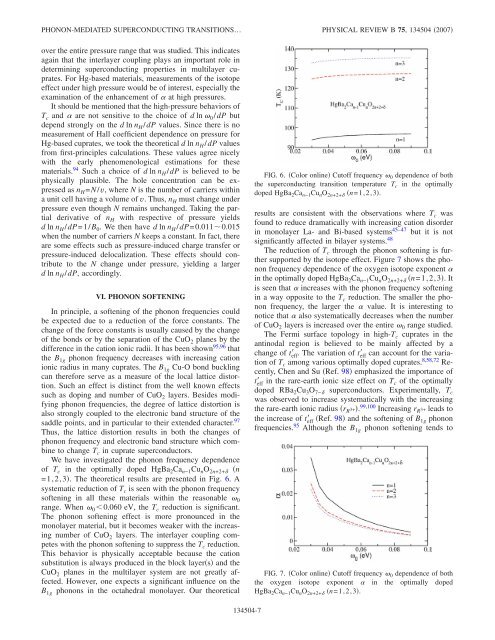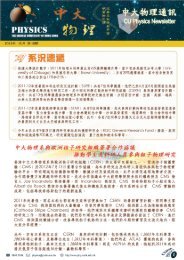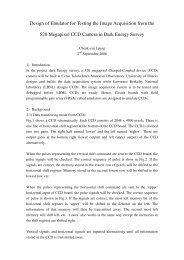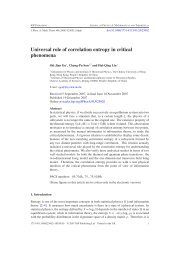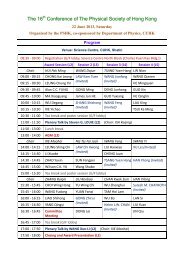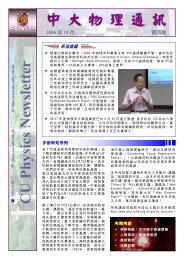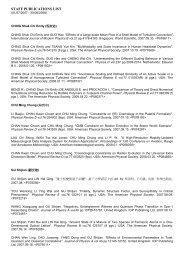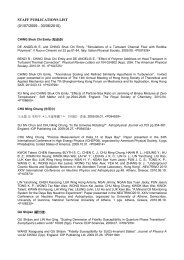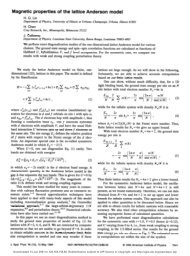Phonon-mediated superconducting transitions in layered cuprate ...
Phonon-mediated superconducting transitions in layered cuprate ...
Phonon-mediated superconducting transitions in layered cuprate ...
You also want an ePaper? Increase the reach of your titles
YUMPU automatically turns print PDFs into web optimized ePapers that Google loves.
PHONON-MEDIATED SUPERCONDUCTING TRANSITIONS…<br />
over the entire pressure range that was studied. This <strong>in</strong>dicates<br />
aga<strong>in</strong> that the <strong>in</strong>terlayer coupl<strong>in</strong>g plays an important role <strong>in</strong><br />
determ<strong>in</strong><strong>in</strong>g <strong>superconduct<strong>in</strong>g</strong> properties <strong>in</strong> multilayer <strong>cuprate</strong>s.<br />
For Hg-based materials, measurements of the isotope<br />
effect under high pressure would be of <strong>in</strong>terest, especially the<br />
exam<strong>in</strong>ation of the enhancement of at high pressures.<br />
It should be mentioned that the high-pressure behaviors of<br />
T c and are not sensitive to the choice of d ln 0 /dP but<br />
depend strongly on the d ln n H /dP values. S<strong>in</strong>ce there is no<br />
measurement of Hall coefficient dependence on pressure for<br />
Hg-based <strong>cuprate</strong>s, we took the theoretical d ln n H /dP values<br />
from first-pr<strong>in</strong>ciples calculations. These values agree nicely<br />
with the early phenomenological estimations for these<br />
materials. 94 Such a choice of d ln n H /dP is believed to be<br />
physically plausible. The hole concentration can be expressed<br />
as n H =N/v, where N is the number of carriers with<strong>in</strong><br />
a unit cell hav<strong>in</strong>g a volume of v. Thus, n H must change under<br />
pressure even though N rema<strong>in</strong>s unchanged. Tak<strong>in</strong>g the partial<br />
derivative of n H with respective of pressure yields<br />
d ln n H /dP=1/B 0 . We then have d ln n H /dP=0.0110.015<br />
when the number of carriers N keeps a constant. In fact, there<br />
are some effects such as pressure-<strong>in</strong>duced charge transfer or<br />
pressure-<strong>in</strong>duced delocalization. These effects should contribute<br />
to the N change under pressure, yield<strong>in</strong>g a larger<br />
d ln n H /dP, accord<strong>in</strong>gly.<br />
VI. PHONON SOFTENING<br />
In pr<strong>in</strong>ciple, a soften<strong>in</strong>g of the phonon frequencies could<br />
be expected due to a reduction of the force constants. The<br />
change of the force constants is usually caused by the change<br />
of the bonds or by the separation of the CuO 2 planes by the<br />
difference <strong>in</strong> the cation ionic radii. It has been shown 95,96 that<br />
the B 1g phonon frequency decreases with <strong>in</strong>creas<strong>in</strong>g cation<br />
ionic radius <strong>in</strong> many <strong>cuprate</strong>s. The B 1g Cu-O bond buckl<strong>in</strong>g<br />
can therefore serve as a measure of the local lattice distortion.<br />
Such an effect is dist<strong>in</strong>ct from the well known effects<br />
such as dop<strong>in</strong>g and number of CuO 2 layers. Besides modify<strong>in</strong>g<br />
phonon frequencies, the degree of lattice distortion is<br />
also strongly coupled to the electronic band structure of the<br />
saddle po<strong>in</strong>ts, and <strong>in</strong> particular to their extended character. 97<br />
Thus, the lattice distortion results <strong>in</strong> both the changes of<br />
phonon frequency and electronic band structure which comb<strong>in</strong>e<br />
to change T c <strong>in</strong> <strong>cuprate</strong> superconductors.<br />
We have <strong>in</strong>vestigated the phonon frequency dependence<br />
of T c <strong>in</strong> the optimally doped HgBa 2 Ca n−1 Cu n O 2n+2+ n<br />
=1,2,3. The theoretical results are presented <strong>in</strong> Fig. 6. A<br />
systematic reduction of T c is seen with the phonon frequency<br />
soften<strong>in</strong>g <strong>in</strong> all these materials with<strong>in</strong> the reasonable 0<br />
range. When 0 0.060 eV, the T c reduction is significant.<br />
The phonon soften<strong>in</strong>g effect is more pronounced <strong>in</strong> the<br />
monolayer material, but it becomes weaker with the <strong>in</strong>creas<strong>in</strong>g<br />
number of CuO 2 layers. The <strong>in</strong>terlayer coupl<strong>in</strong>g competes<br />
with the phonon soften<strong>in</strong>g to suppress the T c reduction.<br />
This behavior is physically acceptable because the cation<br />
substitution is always produced <strong>in</strong> the block layers and the<br />
CuO 2 planes <strong>in</strong> the multilayer system are not greatly affected.<br />
However, one expects a significant <strong>in</strong>fluence on the<br />
B 1g phonons <strong>in</strong> the octahedral monolayer. Our theoretical<br />
PHYSICAL REVIEW B 75, 134504 2007<br />
FIG. 6. Color onl<strong>in</strong>e Cutoff frequency 0 dependence of both<br />
the <strong>superconduct<strong>in</strong>g</strong> transition temperature T c <strong>in</strong> the optimally<br />
doped HgBa 2 Ca n−1 Cu n O 2n+2+ n=1,2,3.<br />
results are consistent with the observations where T c was<br />
found to reduce dramatically with <strong>in</strong>creas<strong>in</strong>g cation disorder<br />
<strong>in</strong> monolayer La- and Bi-based systems 45–47 but it is not<br />
significantly affected <strong>in</strong> bilayer systems. 48<br />
The reduction of T c through the phonon soften<strong>in</strong>g is further<br />
supported by the isotope effect. Figure 7 shows the phonon<br />
frequency dependence of the oxygen isotope exponent <br />
<strong>in</strong> the optimally doped HgBa 2 Ca n−1 Cu n O 2n+2+ n=1,2,3. It<br />
is seen that <strong>in</strong>creases with the phonon frequency soften<strong>in</strong>g<br />
<strong>in</strong> a way opposite to the T c reduction. The smaller the phonon<br />
frequency, the larger the value. It is <strong>in</strong>terest<strong>in</strong>g to<br />
notice that also systematically decreases when the number<br />
of CuO 2 layers is <strong>in</strong>creased over the entire 0 range studied.<br />
The Fermi surface topology <strong>in</strong> high-T c <strong>cuprate</strong>s <strong>in</strong> the<br />
ant<strong>in</strong>odal region is believed to be ma<strong>in</strong>ly affected by a<br />
change of t eff . The variation of t eff can account for the variation<br />
of T c among various optimally doped <strong>cuprate</strong>s. 8,58,72 Recently,<br />
Chen and Su Ref. 98 emphasized the importance of<br />
t eff <strong>in</strong> the rare-earth ionic size effect on T c of the optimally<br />
doped RBa 2 Cu 3 O 7− superconductors. Experimentally, T c<br />
was observed to <strong>in</strong>crease systematically with the <strong>in</strong>creas<strong>in</strong>g<br />
the rare-earth ionic radius r R 3+. 99,100 Increas<strong>in</strong>g r R 3+ leads to<br />
the <strong>in</strong>crease of t eff Ref. 98 and the soften<strong>in</strong>g of B 1g phonon<br />
frequencies. 95 Although the B 1g phonon soften<strong>in</strong>g tends to<br />
FIG. 7. Color onl<strong>in</strong>e Cutoff frequency 0 dependence of both<br />
the oxygen isotope exponent <strong>in</strong> the optimally doped<br />
HgBa 2 Ca n−1 Cu n O 2n+2+ n=1,2,3.<br />
134504-7


